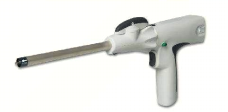Understanding Ligating and Dividing Staplers: A Key Tool in Modern Surgery
Ligating and dividing staplers represent a crucial advancement in surgical technology, specifically designed to facilitate the efficient and safe closure of tissues during operations. These specialized instruments serve a dual purpose: they efficiently ligate (or tie off) blood vessels and other tubular structures while simultaneously dividing or cutting through tissues. This innovative approach n
Ligating and dividing staplers represent a crucial advancement in surgical technology, specifically designed to facilitate the efficient and safe closure of tissues during operations. These specialized instruments serve a dual purpose: they efficiently ligate (or tie off) blood vessels and other tubular structures while simultaneously dividing or cutting through tissues. This innovative approach not only streamlines surgical procedures but also minimizes the time patients spend under anesthesia.
One of the primary benefits of ligating and dividing staplers is their ability to promote hemostasis. During surgery, controlling blood loss is paramount. By securely ligating vessels, these staplers help prevent excessive bleeding, which can lead to complications. Furthermore, the precise cutting mechanism ensures that surrounding tissues remain intact, reducing the risk of damage to adjacent structures.
Another significant advantage of using ligating and dividing staplers is the consistency they provide. Traditional methods of suturing can vary in effectiveness based on the surgeon's technique. In contrast, these staplers deliver uniform application, ensuring that each ligation is performed with the same degree of tension and closure. This consistency contributes to better outcomes, as it reduces the chances of postoperative complications related to insufficient closure.
Ligating and dividing staplers are designed for various surgical specialties, including general surgery, gynecology, and thoracic surgery. Their versatility allows surgeons to use them in diverse procedures, from appendectomies to lobectomies. The range of sizes and configurations available also means that they can be tailored to suit the specific needs of different surgical scenarios.
In addition to enhancing surgical efficiency, ligating and dividing staplers can also positively impact recovery times. By minimizing tissue trauma and promoting rapid healing, patients may experience shorter hospital stays and quicker recoveries. This leads to improved patient satisfaction and a quicker return to their daily activities.
It is important to note that while ligating and dividing staplers are powerful tools, their use requires proper training and understanding of the device. Surgeons and their teams must be well-versed in the operation of these instruments to maximize their benefits while minimizing any potential risks.
In summary, ligating and dividing staplers are integral to modern surgical practices, providing enhanced precision, safety, and efficiency. As technology continues to advance, these tools will likely evolve further, contributing to better surgical outcomes and patient care. Understanding their role in surgical procedures can foster greater appreciation for the innovations shaping the medical field today.
One of the primary benefits of ligating and dividing staplers is their ability to promote hemostasis. During surgery, controlling blood loss is paramount. By securely ligating vessels, these staplers help prevent excessive bleeding, which can lead to complications. Furthermore, the precise cutting mechanism ensures that surrounding tissues remain intact, reducing the risk of damage to adjacent structures.
Another significant advantage of using ligating and dividing staplers is the consistency they provide. Traditional methods of suturing can vary in effectiveness based on the surgeon's technique. In contrast, these staplers deliver uniform application, ensuring that each ligation is performed with the same degree of tension and closure. This consistency contributes to better outcomes, as it reduces the chances of postoperative complications related to insufficient closure.
Ligating and dividing staplers are designed for various surgical specialties, including general surgery, gynecology, and thoracic surgery. Their versatility allows surgeons to use them in diverse procedures, from appendectomies to lobectomies. The range of sizes and configurations available also means that they can be tailored to suit the specific needs of different surgical scenarios.
In addition to enhancing surgical efficiency, ligating and dividing staplers can also positively impact recovery times. By minimizing tissue trauma and promoting rapid healing, patients may experience shorter hospital stays and quicker recoveries. This leads to improved patient satisfaction and a quicker return to their daily activities.
It is important to note that while ligating and dividing staplers are powerful tools, their use requires proper training and understanding of the device. Surgeons and their teams must be well-versed in the operation of these instruments to maximize their benefits while minimizing any potential risks.
In summary, ligating and dividing staplers are integral to modern surgical practices, providing enhanced precision, safety, and efficiency. As technology continues to advance, these tools will likely evolve further, contributing to better surgical outcomes and patient care. Understanding their role in surgical procedures can foster greater appreciation for the innovations shaping the medical field today.
ligating and dividing stapler









